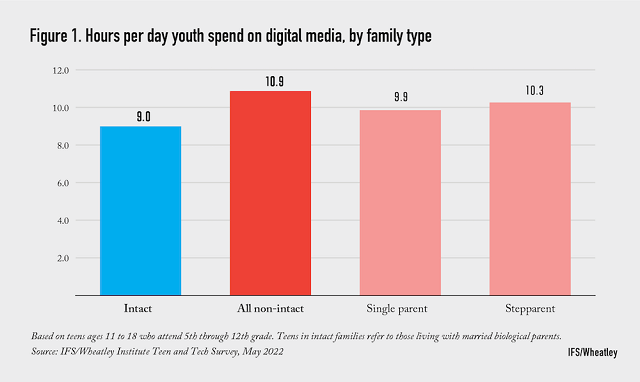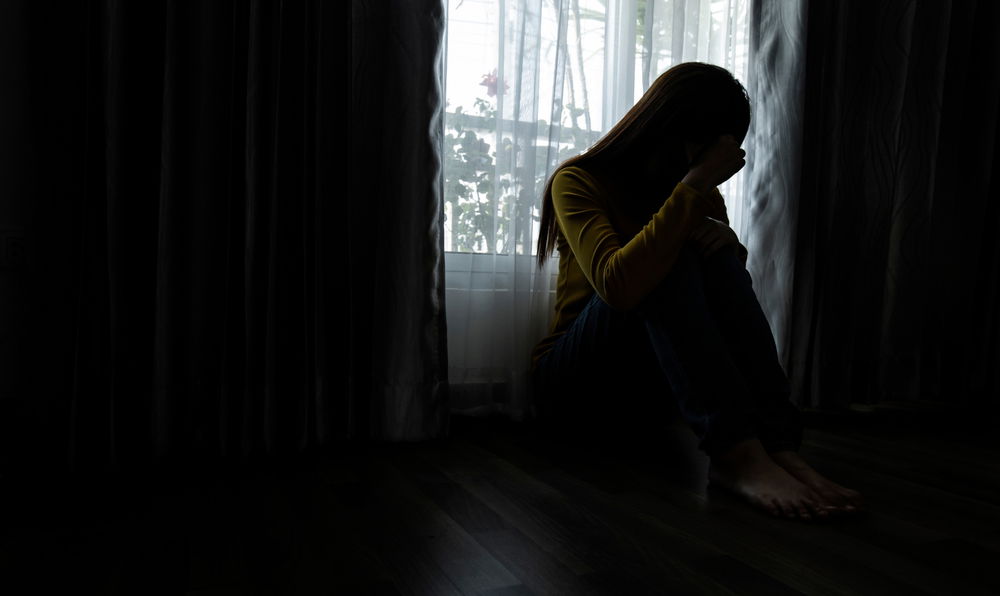Highlights
- Children in non-intact families spend almost two hours more per day on screens than do teens from intact families, per new IFS and Wheatley Institute report. Post This
- Depression, loneliness, and sleep deprivation are lowest for teens from intact families with low digital media usage and highest for teens from non-intact families with high digital media usage. Post This
- A new IFS and Wheatley Institute report examines technology and media use among America’s teens, including teens’ tech use by their family structure. Post This
Editor's Note: The following article is adapted from the new Institute for Family Studies and Wheatley Institute report, Teens and Tech: What Difference Does Family Structure Make? by Jean Twenge, Wendy Wang, Jenet Erickson, and Brad Wilcox.
A few decades ago, teens and their parents often debated family rules around curfews, going out with friends, and using the car. Although these issues still arise, the most fraught discussions in many families are now centered on a different concern: electronic devices.
According to Pew Research Center, 95% of 13- to 17-year-olds have access to a smartphone. Between 2009 and 2017, the number of 8th graders using social media every day rose from 46% to 78%, and the time high school students spent online doubled. Common Sense Media estimates that children ages 8 to 12 spent five and a half hours a day on screens in 2021, and teens ages 13 to 18 spent nearly 9 hours a day. Although the 1998 Children’s Online Privacy Protection Act (COPPA) sets 13 as the minimum age for having a social media account, users are allowed to self-report their age, and, as a result, large numbers of children ages 12 and under use social media.
Thus, enforcing rules around technology use has fallen almost entirely on parents. Limiting technology use is a crucial task for parents given links between excessive use—especially social media—and depression in both correlational and experimental studies. Facebook’s own research found that Instagram made body image issues worse for 1 in 3 teen girls. Particularly because so many children and teens have their own devices, parents face many challenges in regulating their children’s technology use.
These challenges may be greater for mothers and fathers in some family types than others. Because stably married parents generally have more resources and a more consistent bond with the children in their household, they may be better able to handle the challenges of guiding and limiting teen tech use. Having stably married parents means that children are more likely to have access to greater parental resources in terms of time and attention, as well as a more authoritative parenting style marked by clear family rules and consistent rule enforcement. By contrast, single-parent families typically have fewer resources—both emotionally and in terms of time—to devote to their children, which may affect their ability to oversee their children’s media use and screen time. Moreover, stepfamilies are less likely to have the kind of stable ties and clear lines of authority between parents and children that are most conducive to establishing clear and consistent discipline. For these reasons, children being raised in non-intact families may have fewer rules guiding their use of technology and more exposure to that technology.
In this new report, we examine technology and media use among America’s teens, including teens’ tech use by their family structure. Given the apparent emotional and physical fallout of excessive tech use, we also explore how factors associated with teen well-being—e.g., depression, life satisfaction, and sleep—are linked to technology use and family structure. This is the first study to explore how adolescent use of technology varies by family structure and how technology exposure and family structure are both linked to the emotional welfare of today’s teens.
The Institute for Family Studies and the Wheatley Institute surveyed 1,600 adolescents, ages 11 to 18, who were attending 5th through 12th grade in May 2022. The "Teens and Tech Survey," fielded by Ipsos, covered a range of topics related to media consumption, family structure, and the mental health of adolescents.
Among the major findings:
- Children in non-intact families spend almost two hours more per day on screens than do teens from intact families.

- Depression, loneliness, and sleep deprivation are lowest for teens from intact families who have low digital media usage and highest for teens from non-intact families who have high digital media usage. For instance, 13% of children from intact families who are on screens less than 8 hours per day are depressed, compared to 31% of teens from non-intact families who use screens more than 8 hours per day.

- Even though legally not allowed to have a social media account, 7 out of 10 fifth and sixth graders spend at least some time on social media, and nearly 3 out of 10 spend more than three hours a day on social media.
The report concludes with recommendations for parents, including: 1) not allowing teens to have devices in the bedroom after bedtime; 2) delaying giving teens a smartphone until age 16; and 3) limiting the time teens can spend on social media to 2 or 3 hours per day.
Download the full report, Teens and Tech, here.














